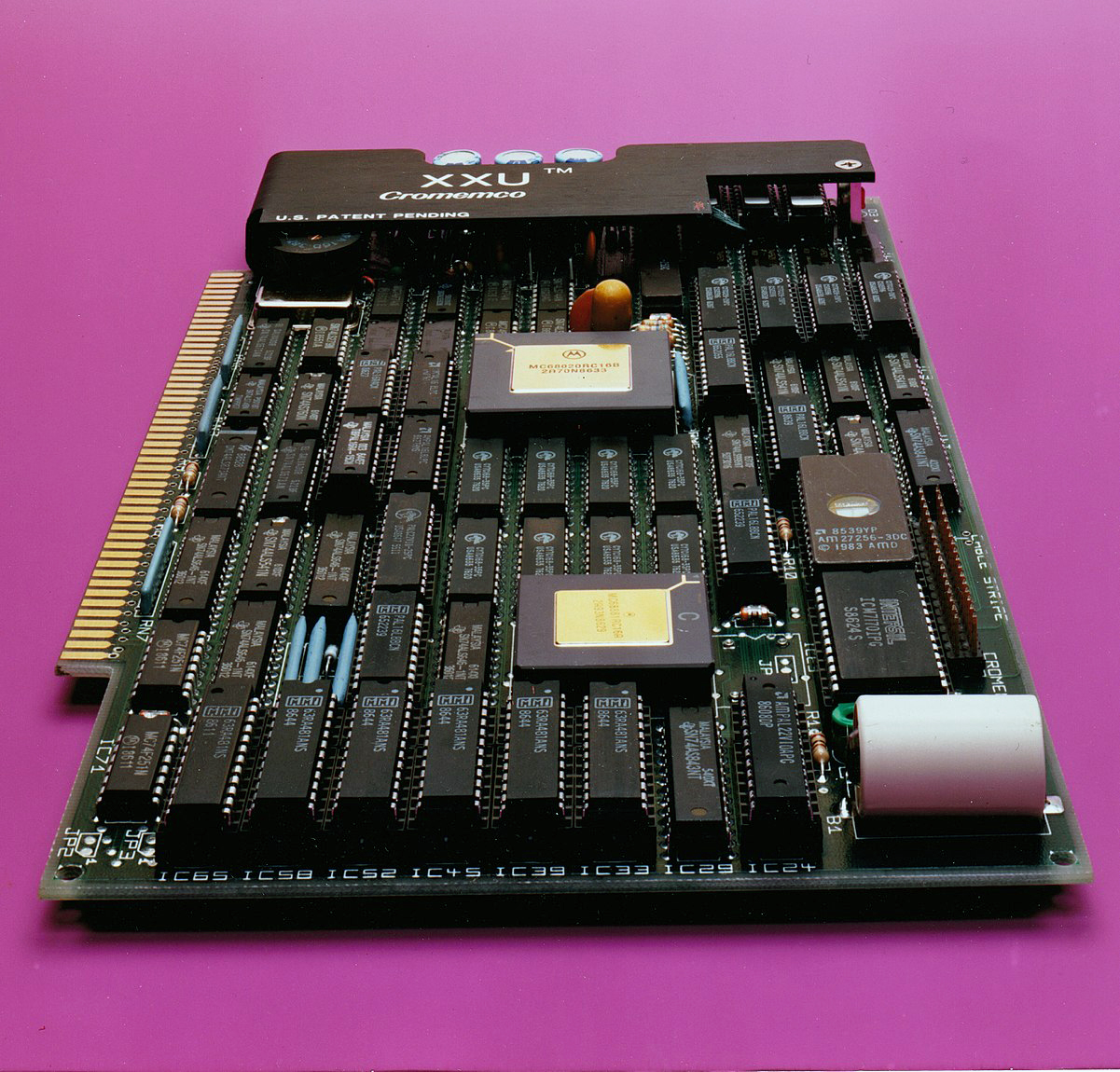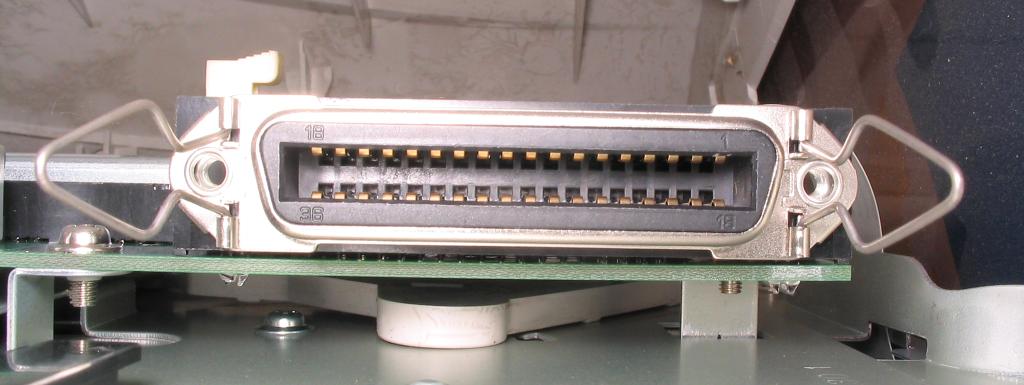|
Cromemco QUADART
{{unreferenced, date=June 2017 The Cromemco Octart was an expansion card made by Cromemco for their range of S-100 bus based computer systems. The card provided eight serial bus channels and a single bi-directional parallel port. The serial connections were often used to interface eight computer terminals to the host system. In combination with the Cromemco Cromix multi-user operating system, this allowed different users to concurrently work on the system. The parallel port was typically connected to an IEEE 1284-type printer. Octart superseded Cromemco's TUART and QUADART and IOP boards. Unlike earlier boards, which merely formatted and exchanged individual data characters, the Octart featured a sophisticated DUART communications circuit plus an independent Z80A processor with 64 KB bytes of memory. This enabled the Octart to: * Perform all protocol and error-detection/recovery functions. * Buffer large amounts of serial data. * Pass only preprocessed data over the host bus using ... [...More Info...] [...Related Items...] OR: [Wikipedia] [Google] [Baidu] |
Cromemco Octart S-100 Card (1983)
Cromemco was a Mountain View, California microcomputer company known for its high-end Z80-based S-100 bus computers and peripherals in the early days of the personal computer revolution. The company began as a partnership in 1974 between Harry Garland and Roger Melen, two Stanford Ph.D. students. The company was named for their residence at Stanford University ( Crothers Memorial, a Stanford dormitory reserved for engineering graduate students). Cromemco was incorporated in 1976 and their first products were the Cromemco Cyclops digital camera, and the Cromemco Dazzler color graphics interface - both groundbreaking at the time - before they moved on to making computer systems. In December 1981, ''Inc.'' magazine named Cromemco in the top ten fastest-growing privately held companies in the U.S. Early history The collaboration that was to become Cromemco began in 1970 when Harry Garland and Roger Melen, graduate students at Stanford University, began working on a series of artic ... [...More Info...] [...Related Items...] OR: [Wikipedia] [Google] [Baidu] |
Expansion Card
In computing, an expansion card (also called an expansion board, adapter card, peripheral card or accessory card) is a printed circuit board that can be inserted into an electrical connector, or expansion slot (also referred to as a bus slot) on a computer's motherboard (see also backplane) to add functionality to a computer system. Sometimes the design of the computer's case and motherboard involves placing most (or all) of these slots onto a separate, removable card. Typically such cards are referred to as a riser card in part because they project upward from the board and allow expansion cards to be placed above and parallel to the motherboard. Expansion cards allow the capabilities and interfaces of a computer system to be extended or supplemented in a way appropriate to the tasks it will perform. For example, a high-speed multi-channel data acquisition system would be of no use in a personal computer used for bookkeeping, but might be a key part of a system used for ind ... [...More Info...] [...Related Items...] OR: [Wikipedia] [Google] [Baidu] |
Cromemco
Cromemco was a Mountain View, California microcomputer company known for its high-end Zilog Z80, Z80-based S-100 bus computers and peripherals in the early days of the personal computer revolution. The company began as a partnership in 1974 between Harry Garland and Roger Melen, two Stanford Ph.D. students. The company was named for their residence at Stanford University (George E. Crothers, Crothers Memorial, a Stanford dormitory reserved for engineering graduate students). Cromemco was incorporated in 1976 and their first products were the Cromemco Cyclops digital camera, and the Cromemco Dazzler color graphics interface - both groundbreaking at the time - before they moved on to making computer systems. In December 1981, Inc. (magazine), ''Inc.'' magazine named Cromemco in the top ten fastest-growing privately held companies in the U.S. Early history The collaboration that was to become Cromemco began in 1970 when Harry Garland and Roger Melen, graduate students at Stanford ... [...More Info...] [...Related Items...] OR: [Wikipedia] [Google] [Baidu] |
S-100 Bus
The S-100 bus or Altair bus, IEEE 696-1983 ''(withdrawn)'', is an early computer bus designed in 1974 as a part of the Altair 8800. The bus was the first industry standard expansion bus for the microcomputer industry. computers, consisting of processor and peripheral cards, were produced by a number of manufacturers. The bus formed the basis for homebrew computers whose builders (e.g., the Homebrew Computer Club) implemented drivers for CP/M and MP/M. These microcomputers ran the gamut from hobbyist toy to small business workstation and were common in early home computers until the advent of the IBM PC. Architecture The bus is a passive backplane of 100-pin printed circuit board edge connectors wired in parallel. Circuit cards measuring 5 × 10-inches serving the functions of CPU, memory, or I/O interface plugged into these connectors. The bus signal definitions closely follow those of an 8080 microprocessor system, since the Intel 8080 microprocessor was the first ... [...More Info...] [...Related Items...] OR: [Wikipedia] [Google] [Baidu] |
Serial Bus
In telecommunication and data transmission, serial communication is the process of sending data one bit at a time, sequentially, over a communication channel or computer bus. This is in contrast to parallel communication, where several bits are sent as a whole, on a link with several parallel channels. Serial communication is used for all long-haul communication and most computer networks, where the cost of cable and synchronization difficulties make parallel communication impractical. Serial computer buses are becoming more common even at shorter distances, as improved signal integrity and transmission speeds in newer serial technologies have begun to outweigh the parallel bus's advantage of simplicity (no need for serializer and deserializer, or SerDes) and to outstrip its disadvantages (clock skew, interconnect density). The migration from PCI to PCI Express is an example. Cables Many serial communication systems were originally designed to transfer data over relatively la ... [...More Info...] [...Related Items...] OR: [Wikipedia] [Google] [Baidu] |
Parallel Port
In computing, a parallel port is a type of interface found on early computers (personal and otherwise) for connecting peripherals. The name refers to the way the data is sent; parallel ports send multiple bits of data at once ( parallel communication), as opposed to serial communication, in which bits are sent one at a time. To do this, parallel ports require multiple data lines in their cables and port connectors and tend to be larger than contemporary serial ports, which only require one data line. There are many types of parallel ports, but the term has become most closely associated with the printer port or Centronics port found on most personal computers from the 1970s through the 2000s. It was an industry ''de facto'' standard for many years, and was finally standardized as IEEE 1284 in the late 1990s, which defined the Enhanced Parallel Port (EPP) and Extended Capability Port (ECP) bi-directional versions. Today, the parallel port interface is virtually non-exis ... [...More Info...] [...Related Items...] OR: [Wikipedia] [Google] [Baidu] |
Computer Terminal
A computer terminal is an electronic or electromechanical hardware device that can be used for entering data into, and transcribing data from, a computer or a computing system. The teletype was an example of an early-day hard-copy terminal and predated the use of a computer screen by decades. Early terminals were inexpensive devices but very slow compared to punched cards or paper tape for input, yet as the technology improved and video displays were introduced, terminals pushed these older forms of interaction from the industry. A related development was time-sharing systems, which evolved in parallel and made up for any inefficiencies in the user's typing ability with the ability to support multiple users on the same machine, each at their own terminal or terminals. The function of a terminal is typically confined to transcription and input of data; a device with significant local, programmable data-processing capability may be called a "smart terminal" or fat client. A ter ... [...More Info...] [...Related Items...] OR: [Wikipedia] [Google] [Baidu] |
Operating System
An operating system (OS) is system software that manages computer hardware, software resources, and provides common services for computer programs. Time-sharing operating systems schedule tasks for efficient use of the system and may also include accounting software for cost allocation of processor time, mass storage, printing, and other resources. For hardware functions such as input and output and memory allocation, the operating system acts as an intermediary between programs and the computer hardware, although the application code is usually executed directly by the hardware and frequently makes system calls to an OS function or is interrupted by it. Operating systems are found on many devices that contain a computer from cellular phones and video game consoles to web servers and supercomputers. The dominant general-purpose personal computer operating system is Microsoft Windows with a market share of around 74.99%. macOS by Apple Inc. is in second place (14.84%), and ... [...More Info...] [...Related Items...] OR: [Wikipedia] [Google] [Baidu] |
IEEE 1284
IEEE 1284 is a standard that defines bi-directional parallel communications between computers and other devices. It was originally developed in the 1970s by Centronics, and was widely known as the Centronics port, both before and after its IEEE standardization. History In the 1970s, Centronics developed the now-familiar printer parallel port that soon became a ''de facto'' standard. Centronics had introduced the first successful low-cost seven-wire print head, which used a series of solenoids to pull the individual metal pins to strike a ribbon and the paper. A dot matrix print head consists of a series of metal pins arranged in a vertical row. Each pin is attached to some sort of actuator, a solenoid in the case of Centronics, which can pull the pin forward to strike a ribbon and the paper. The entire print head is moved horizontally in order to print a line of text, striking the paper several times to produce a matrix for each character. Character sets on early printers ... [...More Info...] [...Related Items...] OR: [Wikipedia] [Google] [Baidu] |
Central Processing Unit
A central processing unit (CPU), also called a central processor, main processor or just processor, is the electronic circuitry that executes instructions comprising a computer program. The CPU performs basic arithmetic, logic, controlling, and input/output (I/O) operations specified by the instructions in the program. This contrasts with external components such as main memory and I/O circuitry, and specialized processors such as graphics processing units (GPUs). The form, design, and implementation of CPUs have changed over time, but their fundamental operation remains almost unchanged. Principal components of a CPU include the arithmetic–logic unit (ALU) that performs arithmetic and logic operations, processor registers that supply operands to the ALU and store the results of ALU operations, and a control unit that orchestrates the fetching (from memory), decoding and execution (of instructions) by directing the coordinated operations of the ALU, registers and other co ... [...More Info...] [...Related Items...] OR: [Wikipedia] [Google] [Baidu] |
Read-only Memory
Read-only memory (ROM) is a type of non-volatile memory used in computers and other electronic devices. Data stored in ROM cannot be electronically modified after the manufacture of the memory device. Read-only memory is useful for storing software that is rarely changed during the life of the system, also known as firmware. Software applications (like video games) for programmable devices can be distributed as plug-in cartridges containing ROM. Strictly speaking, ''read-only memory'' refers to memory that is hard-wired, such as diode matrix or a mask ROM integrated circuit (IC), which cannot be electronically changed after manufacture. Although discrete circuits can be altered in principle, through the addition of bodge wires and/or the removal or replacement of components, ICs cannot. Correction of errors, or updates to the software, require new devices to be manufactured and to replace the installed device. Floating-gate ROM semiconductor memory in the form of erasab ... [...More Info...] [...Related Items...] OR: [Wikipedia] [Google] [Baidu] |
.jpg)









